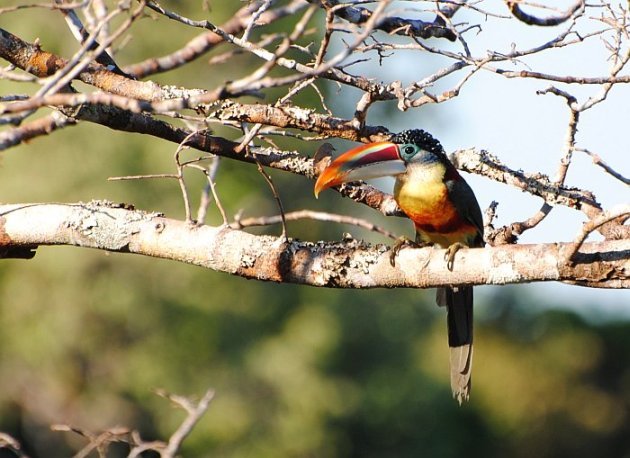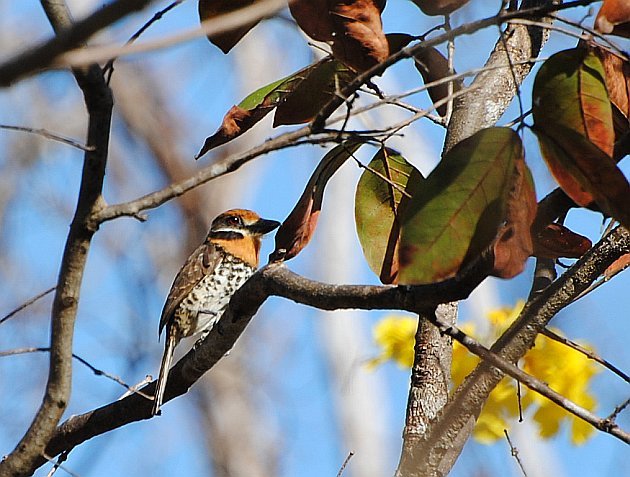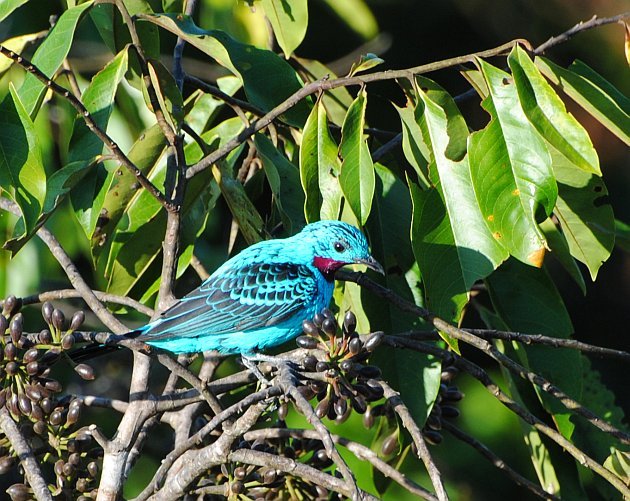
After over a year of planning and preparation (and after a quick trip to the Pantanal and Chapada dos Guimaraes), I finally arrived at Cristalino Jungle Lodge on the afternoon of August 1st, 2013 to begin my nearly three month long guiding experience here. I quickly befriended all of the other volunteer guides, who have all been extremely helpful and generous with their knowledge and previous experience. I must mention one guide in particular: Eduardo Patrial, who has helped me more than anyone else to make sense out of a virtual avalanche of new knowledge of bird calls, behaviors, and habitat preferences of an avifauna that is over 600 species strong with new additions every year. Eduardo leads guided tours privately as well as for Birdquest and can be contacted via email for such inquiries: epatrial@gmail.com.
Spotted Puffbird on the Serra Trail!
Upon arrival at Cristalino Jungle Lodge, I was immediately struck by how different this part of the Amazon Rainforest is in comparison to the lodges along the Napo River in Ecuador. The forest here is almost entirely terra firme (does not flood in the wet season) with ancient mountain ridges called ‘Serras’ dominated by tropical deciduous dry forest with their own unique ecosystems (including an undescribed species of poison dart frog). It is a drier forest overall with patches of Guadua bamboo containing such specialties as Manu Antbird and Large-headed Flatbill.
Despite being among the most heavily birded locations in the Amazon Basin, it hosts a relatively large number of recently described species such as Alta Floresta Antpitta, Kawall’s Parrot, Tapajos Hermit, and Cryptic Forest-Falcon. This fact implies that the huge swaths of Amazonian rainforest that are rarely if ever surveyed by ornithologists or birders must still contain a large number of unique or charismatic species that have yet to be identified.
The amazingly brilliant Spangled Cotinga is regularly seen from both canopy towers.
From a birders perspective, Cristalino Jungle Lodge is situated in a birding paradise. In the fourteen days that I have been here, I have already seen nearly 300 species of bird with new additions being added on every single outing. My sightings include some of the most exciting, charismatic, and desirable birds to see on Earth such as Agami Heron, Red-fan Parrot, and Black-spotted Bare-eye; regional endemics such as Black-girdled Barbet, Kawall’s Parrot, and Bare-eyed Antbird; regional rarities such as Dotted Tanager, Fiery-tailed Awlbill and Purple-throated Cotinga; and obscure austral migrants such as Southern Scrub-Flycatcher and Small-billed Elaenia. My personal favorite sighting was of a Harpy Eagle from Tower I. Volunteer guide Stephen spotted the bird in a snag in the distance and said “there is a huge eagle up in that tree” to which I stated in shock “that’s the eagle!” We proceeded to watch it for over 30 minutes until it was flushed from its perch by a small flock of raucous Blue-and-yellow Macaws. It really seems like anything is possible here at Cristalino Jungle Lodge and volunteer guides regularly amass trip lists of over 400 species during the two to three months that they are here.
Sunsets at Ilha Ariosto…
Birds here live in a world of sound, and in order to be a successful guide, learning all of their calls is paramount. Although the first few days of birding felt overwhelming, the birds and their calls are beginning to sink in, the understory antbirds and flycatchers are gradually becoming more easily visible, and the rhythm and pulse of this forest is becoming clearer — and with this knowledge, I am able to appreciate this rainforest even more and realize how so many species are actually quite common by call.
My first set of clients arrive in just a few days… to be continued…
















Thanks for posting about your time at Cristalino, looking forward to more posts!
i was bitten by many ticks on the first day of a fabulous stay.
Then I took more precautions. However, I’m worried because a Brazian friend told me that if you leave part of the tick inside your skin the tick somehow grows backs.
It sounds like a tall tale, but I would like to know the truth about these ticks so that I can deal with it accordingly.
Many thanks!